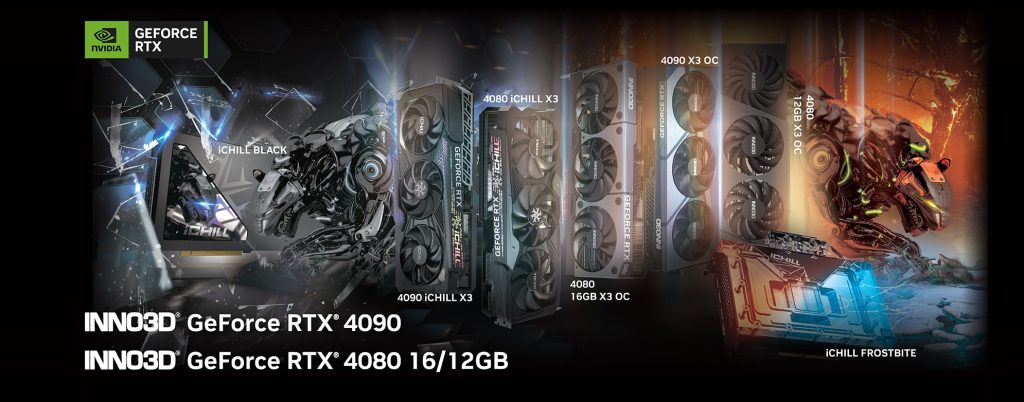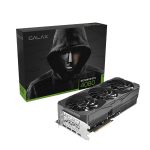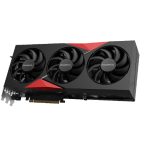Last night, Nvidia officially announced the first RTX 40 series GPUs – the RTX 4090 and a 16GB and 12GB version of the RTX 4080. Like most GPU launches, these announcements are accompanied by a range of custom-cooled cards being announced by board partners. Here, we round-up the custom cards announced so far.
Almost every AIB partner has shared at least one RTX 4090/4080 graphics card. That includes MSI, Asus, Gigabyte, Zotac, Inno3D, Gainward, PNY, Palit, Galax, and Colorful. The most noticeable absence is EVGA, which ended its partnership with Nvidia a few days ago.

Starting with MSI, the company is sticking with the Ventus 3X, Gaming Trio and Suprim cooler line-up. However, the latter has now been expanded with Suprim Liquid cards, featuring a 240mm AIO cooler. The three air-cooled models will continue using a 3-fan solution, with the thickest cards using up to 3.75 expansion slots. The Suprim, Suprim Liquid, and Gaming Trio cards will feature RGB lighting, Torx 5.0 fans (Suprim Liquid only has one), and Dual BIOS. As for Ventus, the more modest series will be slimmer than the other air-cooled cards and will use Torx 4.0 fans.
Asus has only introduced two models: the TUF Gaming and the ROG Strix. The TUF Gaming cards will retain a similar design to previous generations, right down to the colour scheme, RGB lighting and pass-through cooling. However, the cards are now much thicker, going up to 3.65 slots thick, and you'll find larger fans to improve airflow.
The ROG Strix series had a significant redesign, now with a blue, red, and grey colour scheme. Unlike the new TUF Gaming cards with varying sizes depending on the GPU, the new Strix models are all 3.5-slot thick and 357mm long. According to Asus, the cooling solution of the ROG Strix models should be pretty unique, as it combines the big GPU heatsinks with a vapour chamber with milled channels underneath the seven heat pipes that sink into it.
Gigabyte has also prepared a whole collection of new graphics cards for the RTX 40 series. Besides the usual Windforce and Gaming OC models, the company is also launching the Aorus Master and the Aorus Xtreme Waterforce. The first two are pretty standard, featuring a three-fan cooling solution with a redesigned shroud. The air-cooled Aorus model was heavily modified, now featuring an LCD that users can customise with text, images, gifs or system monitoring. Lastly, the Xtreme Waterforce should have a built-in water block, making it custom loop-ready out-of-the-box.

Zotac has also redesigned all of its coolers. The Trinity and AMP Extreme Airo models are now more rounded. All models feature nine heat pipes and a 3-fan cooling solution, but the AMP Extreme Airo cards have the middle fan counter-rotating for even better cooling performance. Similar to the new ROG Strix card, the new Zotac cards also feature a vapour chamber on the heatsink. Alongside the new cards, Zotac will also launch the new Gaming FireStorm Utility monitoring/OC tool, where users can create OC profiles, configure the RGB lighting and change BIOS with a push of a button.

Inno3D also has a decently sized launch line-up, including iChill X3 and X3 OC air-cooled cards, the hybrid-cooled iChill Black and the water-cooled iChill Frostbite. Starting from the bottom, the X3 OC cards will be the most standard, packing a 3-fan cooling solution (3x98mm), nine heat pipes, and a large vapour chamber to cool the GPU. Then we have the iChill X3, which looks like a minor upgrade over the X3 OC, featuring counter-rotating fans (three with 98mm) and RGB lighting.
Then, we have the iChill Black, which comes with an undisclosed AIO cooler and a fan under the shroud for additional cooling. Design-wise, the iChill Black seems to be the most minimalistic out of all new RTX 40 cards, which might be enough to convince some. The last Inno3D card is the iChill Frostbite, the company's flagship. With ARGB LEDs, patented sealing screws, and a mix of copper and nickel-plated parts, this water loop-oriented GPU comes in compact packaging that fits inside most cases.
Besides the Phoenix cards, Gainward will also have the Phantom and Phantom Reunion series. As the name suggests, the Phantom cards will have a darker colour scheme. However, the standard Phantom will still have two lighting strips and an ARGB side logo to give it some colour. On the other hand, the Phantom Reunion series (middle card) seems to be the lower-end model, as it will only be available as an RTX 4080 12GB card.
The Phoenix models will be the more colourful alternative to the Phantom cards, packing a large ARGB LED array across the whole card that can easily be synchronised with any ARGB system thanks to the Auto Sync RGB technology. Like the standard Phantom GPUs, it uses the new Cyclone fans, diffuser fins, and Hyper Conductive heat pipes to cool the GPU.

PNY is also redesigning its series for the RTX 40 GPUs. The new XLR8 and Verto models have been modified to meet the demands of the new RTX 40 series GPUs, using 3-fan cooling solutions, up to eight heat pipes and support kits to prevent them from sagging or bending. Additionally, they feature EPIC-X RGB lighting that can be customised via PNY's VelocityX control software.
Galax decided to start with a single series of graphics cards, probably expanding in the future. The Serious Gaming series will include RTX 4090, 4080 16GB, and 4080 12GB cards, all with ARGB LEDs, up to nine heat pipes, and up to 102mm dual-bearing fans in three-fan configurations. The RTX 4090 cooling features are one step above the others, as it features a vapour chamber cooling base. The three models feature 1-Clip Booster 2.0, enabling the factory OC profile with a single click.

Palit will release GameRock and GamingPro series cards powered by RTX 40 series GPUs. The GameRock models look similar to their predecessors, but this time there's an alternative darker model called OmniBlack. The ARGB lighting on the crystal-like surface remains intact, but the black crystals give it an interesting new look. Both GameRock and GamingPro cards sue Gale Hunter fans, Y Formula fins and Composite heat pipes. However, GameRock cards stand above the rest in terms of cooling thanks to the built-in vapour chamber. Moreover, you can count on the Anti-Gravity plate and Exquisite Metal backplate to prevent the card from bending.
Finally, we have Colorful, which will be releasing RTX 40 series cards under the BattleAx, Vulcan, and Neptune series. The BattleAx will be the lower-end of the three, featuring an attractive black and red design and three 98mm fans. Moving on to the Vulcan cards, one of its highlights is the new Hurricane Scythe fan blades that produce more airflow at a lower noise level. Moreover, the Vulcan cards feature a dock station where you choose to mount RGB strips or a customisable iGame Smart LCD. Alternatively, you can use the display dock to place the LCD elsewhere.
Colorful's flagship is the Neptune series, sporting a silver and white design with RGB strips and three RGB fans on the 360mm AIO cooler. The AIO cooler paired with the full-cover copper water block covering the GPU and VRAM will be responsible for ensuring the GPU uses its maximum performance at all times, regardless of the load. Another advantage is the 2-slot design, making it comparatively slimmer than most RTX 40 series cards above.
Discuss on our Facebook page, HERE.
KitGuru says: Are you planning on upgrading to an RTX 40 GPU? Will you be going for an AiB card over the Founders Edition?
 KitGuru KitGuru.net – Tech News | Hardware News | Hardware Reviews | IOS | Mobile | Gaming | Graphics Cards
KitGuru KitGuru.net – Tech News | Hardware News | Hardware Reviews | IOS | Mobile | Gaming | Graphics Cards















